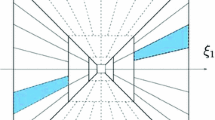Abstract
Target detection for SAR images has many important applications; however there is a challenge that inherent speckle noise in SAR images may cause serious interference. Beamlet transform is a multi-scale image analysis method to extract line features in an image with strong anti-noise capacity. In this paper a method based on Beamlet transform is proposed for target detection for SAR images. It takes the advantage of Beamlet transform in feature extraction. Firstly Beamlet transform is applied on a SAR image to obtain Beamlet coefficients,which are then processed by a coefficient filtering algorithm to remove unreal Beamlet features caused by noise. The remained Beamlet features are fed to the BD-RDP (Beamlet-decorated recursive dyadic partition) algorithm for optimization and then clustered by NEC (Nearest Endpoint Clustering) algorithm to detect targets. The experimental results show that this method is able to detect target directly in a SAR image without pre-filtering. Further more, it still works well under the background of strong speckle noise.








Similar content being viewed by others
References
Aanstassopoulos V, Lampropoulos G (1992) A new and robust CFAR detection algorithm. IEEE Transon AES 28(2):420–427
Anastassipoulos V, Lamproulos GA (2005) Optimal CFAR detection in weibull clutter. IEEE Transon AES 31(1):52–64
Anastassopoulos V (1999) High resolution radar clutter statistics. IEEE Trans AES 35(1):43–59
Brunner D, Lemoine G, Bruzzone L (2012) Polarimetric SAR target detection using the reflection symmetry. IEEE Geosci Remote Sens Lett 9(6):557–561
di Bisceglie M, Galdi C (2005) CFAR detection of extended objects in high-resolution SAR images. IEEE Transon GRS 43(4):833–843
Donoho DL, Huo X (2000) Beamlets pyramids: a new form of multiresolution analysis,suited for extracting lines, curves, and objects from verynoisy image data. Proc SPIE 4119(7):434–444
Donoho DL, Huo X (2001) Beamlets and multiscale image analysis. Multiscale and multiresolution methods. Springer Lect Notes Comput Sci Eng 20:149–196
Farrouki A, Barkat M (2005) Automatic censoring CFAR detector based on ordereddata variability for nonhomogeneous environments. IEE Proc-Radar Sonar Navig 152(1):43–51
Gao G (2010) A parzen-window-kernel-based CFAR algorithm for ship detection in SAR images. IEEE Geosci Remote Sens Lett 8(3):557–561
Han P, Renbiao W, Wang Y, Wang Z (2003) An efficient SAR ATR approach. IEEE Int Conf Acoust Speech Sig Proc 2:429–433
Kaplan LM, Improved SAR (2001) Target detection via extended fractal features. IEEE Trans Aerosp Electron Syst 37(2):436–451
Kaplan LM, Murenzi R, Namuduri K (1999) Extended fractal feature for first stage SAR target detection. Proc SPIE 3721(4):35–46
Na W, XiangMo Z, XiaoYu D et al. (2011) Beamlet Transform Based Pavement Image Crack detection. Int Conf Intell Comput Technol Autom:881–883
Novak LM et al (1994) Radar target identification using spatial matched filters. Patten Recog 27(4):607–617
Qin X, Zhou S, Zou H (2013) A CFAR detection algorithm for generalized gamma distributed background in high-resolution SAR images. IEEE Geosci Remote Sens Lett 10(4):806–810
Salazar JS (1998) Statistical modeling of target and cluter in single-look non-polorimetric SAR imagery. Int Conf Sig Image Proc, Las egas, USA:21–23
Strickland RN, Hahn HI (1997) Wavelet transform methods for object detection and recovery. IEEE Trans Image Proc 6(5):724–735
Yang Z, Huang X, Zhou Z (2007) Multiresolution feature extraction in target detection of UWB SAR. Asian and Pacific Conference on Synthetic Aperture Radar (APSAR):457–461.
Ying L, Salari E (2009) Beamlet transform based technique for pavement image processing and classification. IEEE Int Conf Elec/Inf Technol:141–145
Yuan Z, He Y, Cai F (2012) Fast algorithm for maneuvering target detection in SAR imagery based on gridding and fusion of texture features. Geo-spatial Inf Sci 14(3):169–176
Zhou G, Cui Y, Chen Y (2011) Linear feature detection in polarimetric SAR images. IEEE Trans Geosci Remote Sens 49(4):1453–1463
Zhu Y, Salari E (2011) Extraction of linear features based on beamlet transform. IEEE Int Conf Elec/Inf Technol:1–6
Acknowledgments
This paper was sponsored by the National Natural Science Foundation of China (No. 40971206)
Author information
Authors and Affiliations
Corresponding author
Rights and permissions
About this article
Cite this article
Lin, Z., Yan, J. & Yuan, Y. Target detection for SAR images based on beamlet transform. Multimed Tools Appl 75, 2189–2202 (2016). https://doi.org/10.1007/s11042-014-2401-8
Received:
Revised:
Accepted:
Published:
Issue Date:
DOI: https://doi.org/10.1007/s11042-014-2401-8




